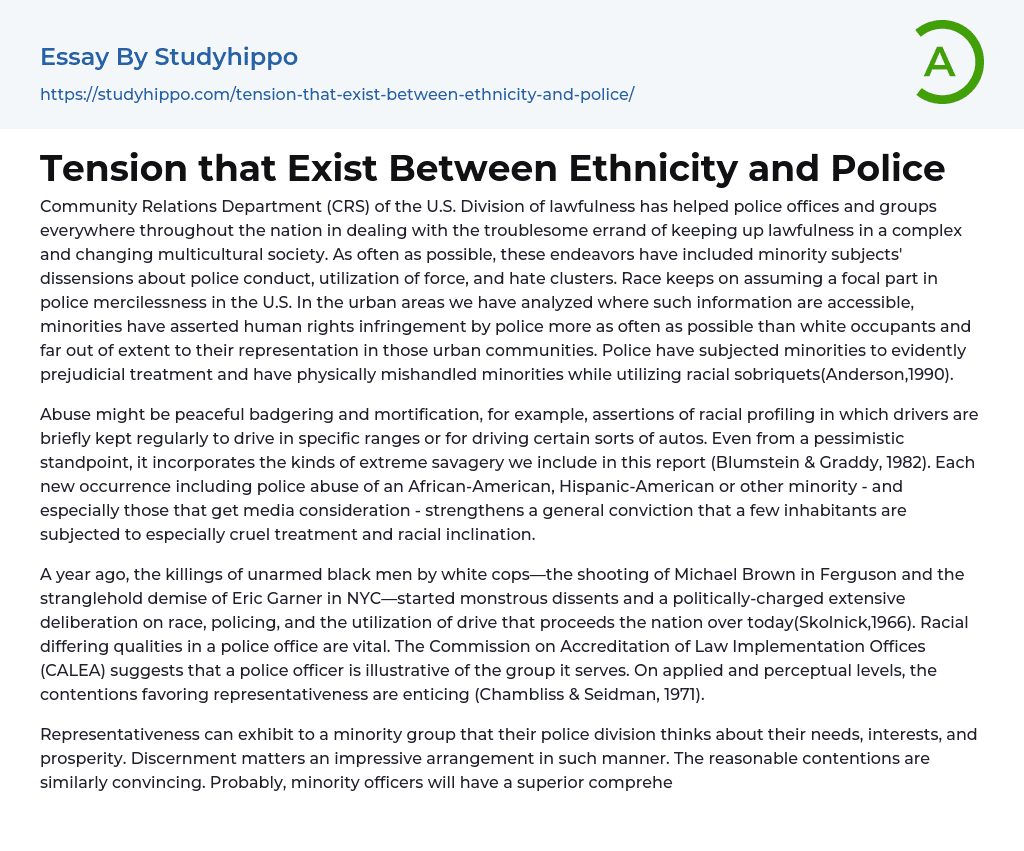

Tension that Exist Between Ethnicity and Police Essay Example
The Community Relations Department (CRS) of the U.S. Division of lawfulness has assisted police offices and communities throughout the nation in managing the challenging task of maintaining lawfulness in a complex and evolving multicultural society. These efforts often address minority subjects' complaints regarding police behavior, use of force, and hate groups.
Police brutality in the United States is significantly influenced by race. According to our research, minorities in cities with available data report a higher number of human rights violations by the police compared to white residents, despite being a minority themselves in these cities. The mistreatment experienced by minorities includes discriminatory treatment, physical abuse, and the use of racial slurs (Anderson, 1990). This mistreatment can take various forms, ranging from subtle harassment such as allegations of racial profiling based on location or car type to extrem
...e acts of violence discussed in this report (Blumstein & Graddy, 1982). Each incident of police misconduct towards African-American, Hispanic-American, or other minority individuals - especially those that gain media attention - reinforces the perception that certain individuals face harsher treatment due to racial bias.
The killings of unarmed black men by white police officers, such as the shooting of Michael Brown in Ferguson and the stranglehold death of Eric Garner in NYC, have ignited widespread protests and a heated national discussion on race, policing, and the use of force (Skolnick,1966). It is crucial to acknowledge the importance of racial diversity within law enforcement. According to the Commission on Accreditation of Law Enforcement Agencies (CALEA), a police force should reflect the demographics of its community. There are compelling arguments both practically and perceptually for having representation (Chambliss & Seidman
1971). Representation can send a powerful message to minority groups that their needs, interests, and well-being are valued by their police department. Perception plays a significant role in addressing this issue.
The logical arguments are equally persuasive. Minority officers are likely to have a better understanding of the social norms and beliefs of residents in a minority neighborhood. Individuals tend to feel more comfortable with law enforcement officials who resemble them and share their perspectives, as well as possess an understanding of community issues (Chambliss, 1995). It seems that minority officers will be better prepared to handle difficult encounters with individuals of their own race due to their intimate knowledge of the background, history, and experiences of people in those minority neighborhoods who may require police assistance.
Despite conflicting experimental evidence, it is crucial for police departments to have diversity in terms of race and ethnicity (Vicchio, 1997). It is essential for the effective functioning of the police force to have a diverse representation. As police officers progress in their careers, their behavior tends to improve. However, for police organizations to fully benefit from diversity, they must offer opportunities for minority officers in various roles such as detectives, supervisors, commanders, and administrators (Geller & Hans, 1996). This ensures that the influence of minority officers extends beyond lower ranks and also encompasses higher ranks when it comes to policies, practices, and procedures. The change in organizational culture can only occur if minority officers are able to advance beyond entry-level positions.
There are various models of oversight for non-military personnel, all of which recognize the importance of civilian control and responsiveness to community concerns. The participation of community groups and
organizations, such as local chapters of the American Civil Liberties Union, is crucial. In cases where other methods fail, the U.S. Department of Justice has the authority to take legal action against officers through criminal and civil litigation if they engage in behavior that violates constitutional rights (Jacobson, 2005).
Work Cited
- Anderson, E. Streetwise: Race, Class, and Change in an Urban Community. Chicago: University of Chicago Press; 1990.
- Blumstein, A., ; Graddy, E. Prevalence and Recidivism in Index Arrests: A Feedback Model. Law and Society Review.1982; 16(2):265–290.
- Chambliss,W.J.The Institutionalization of Racism through Law.In Hawkins Darnell.,editor.Race Ethnicityand Crime.Albany:State Universityof New York Press;1995.
pp. 235–258.
New Haven, CT: Yale University Press.



